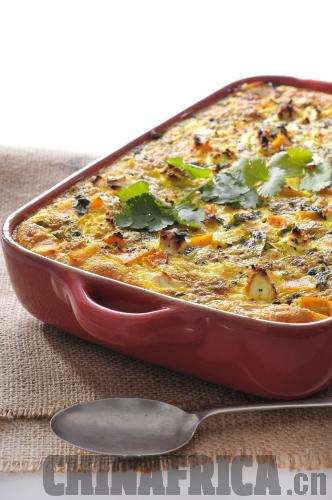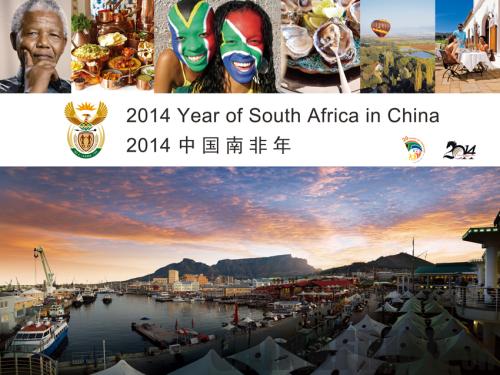| 
Bobotie
During the state visit of President Xi Jinping to South Africa in March 2013, the presidents of South Africa and China agreed to designate 2014 as the Year of South Africa in China, not only to showcase the achievements of the Republic of South Africa since 1994, but also to celebrate the excellent bilateral relations between the two countries.
Launched on April 29, the Year of South Africa in China kicked off with a food festival in Beijing, which hosted the week-long Food & Wine Classic to present South African cuisine. In fact, Chinese who live in Beijing are no strangers to South African cuisine. In the city's commercial center, Pinotage, a restaurant that features authentic South African food, has proved very popular with the locals.
Fascinated with Pinotage wine, Cao Dong began his wine business in China in 2003, in the process falling in love with South African culture. It wasn't long before the idea to open a restaurant featuring South African culture was born.
His restaurant soon became popular among the South African expatriates in Beijing and a favorite of South African Embassy staff in China. But in recent years he has seen a marked rise in Chinese customers, eager to try something new.
"Our restaurant always attracts those people who love the taste and culture of South Africa," Cao said. "Every customer will find one of the different flavors that goes directly to their heart."
But what are typical South African flavors and cuisine? It's difficult to identify due to the country's complex historical background and wide range of cultures. The South African food scene offers a fascinating variety of delicious dishes. It all comes together in a blend of Dutch and English settlers cooking styles and the heavily spiced foods of Malays, Indians and Indonesians who were brought to South Africa as slaves and servants in the 19th and early 20th centuries.
This exotic blend works in harmony with traditional African meat dishes, generally cooked over an open fire (shisa nyama – grilled meat) or in a three-legged cast iron pot (potjie stew). A starch usually accompanies the meat: either mieliepap (corn porridge), potatoes or rice. Beetroot, carrots, cabbage and pumpkin are the vegetables most commonly served.
Many other countries also brought diversity to South African cuisine. The early French settlers brought their wine making skills, establishing vineyards in the country's Western Cape region. Germans introduced baked goods and pastries while the British brought meat pies. Foods from India, China and Indonesia also influenced the South African diet.
Here are some typical South African foods recommended by the South African Embassy in Beijing:
» Boerewors, one of the most popular foods throughout Southern Africa, is based on an older traditional Dutch sausage. It contains beef, as well as lamb or pork or a mixture of lamb and pork, along with spices and other ingredients. At a roadside stands, boerewors is char-grilled over an open-flame and served in rolls with mustard and tomato sauce.
» Bunny chow, a street food favorite using a hollowed-out half- or quarter-loaf of white bread, filled with a blistering-hot meat and vegetable curries.
» Pickled fish, the favorite South African food eaten at Easter time together with Hot Cross Buns, was originally devised by Western Cape Malay fishermen. It is a delicious meal served with salads and crusty bread.
» Bobotie and Yellow Rice, a classic South African dish full of Malaysian influence, with curry flavored beef and fruit served with fragrant yellow rice.
» Tripe, a traditional treat, is favored by most Africans. In the Western Cape region it is considered a regional delicacy and is often served lightly curried with small new potatoes and fried onions.
» Morogo vegetable, a type of wild spinach. Combined with butter-braised onions and tomato or mixed into corn meal porridge, it is a rural ingredient with mainstream appeal. Amadumbe is a sweet potato and peanut mash. A tasty restaurant variation of the dish is to cook sweet potatoes, mash them with butter and sprinkle them with roasted peanuts, topped off with a drizzle of honey.
» Chakalaka spicy relish, a favorite condiment served alongside a main course, consists of grated carrots, green peppers, sliced onion, vinegar, chili and each maker's secret ingredient to distinguish it from others.
» Cape Breyani, a classic of Malay cuisine comprising layers of marinated meat, rice, lentils and spices topped with crisp-fried onions and hard-boiled eggs. This one-pot, slow-cooked dish, a favorite for feeding large crowds at special occasions and celebrations, was brought to the Cape Town from the East during the earliest days of the slave trade along with other "Malay" dishes such as bredies, pickled fish, denningvleis and bobotie.
» Biltong, South Africa's most popular snack food. This jerky-type air-dried salted meat (usually beef of game) was a life-sustaining mainstay of the Dutch Boers during their historic, northward Great Trek into Africa's interior in the 1830s.
» Melktert (milk tart) custard, made with milk-egg-and-sugar prepared in a round pastry shell and Koeksisters, plaited dough sugar pastry, are favorites for those with a sweet tooth.

|